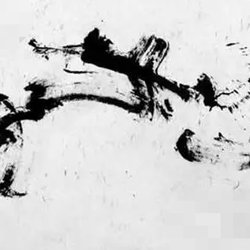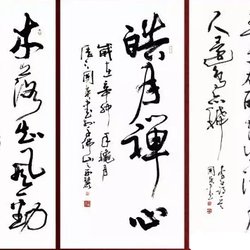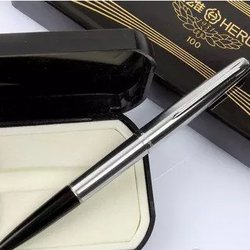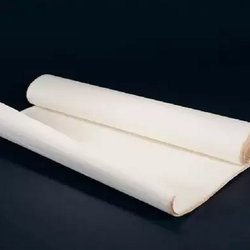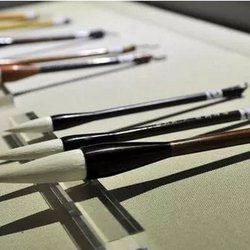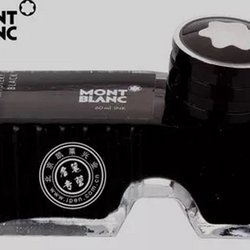The inkstone is one of the four treasures of the study. Inkstones originated in the early Yin and Shang Dynasties, when pen-and-ink inkstones began to take rough shape. Since the advent of the writing brush, people first dipped the pen into graphite to write, which was inconvenient and unable to write larger characters. Therefore, some smart people thought of grinding the ink on something hard first. into juice, would it be more convenient to write in this way? So, people began to try on stones, and slowly formed inkstones. In ancient times, stone inkstones were the most common. After thousands of years of testing, stone inkstones are still the best.
An inkstone is equivalent to a container, mainly used to grind ink. Therefore, the inkstone is required to be made of a material that is fine and moist, easy to ink, and the ink is fine and even without residue. Inkstones can also be divided into stone inkstones, pottery inkstones, brick inkstones, jade inkstones, etc. The most famous ones are Duan inkstone produced in Guangdong and She (shè) inkstone produced in Anhui.
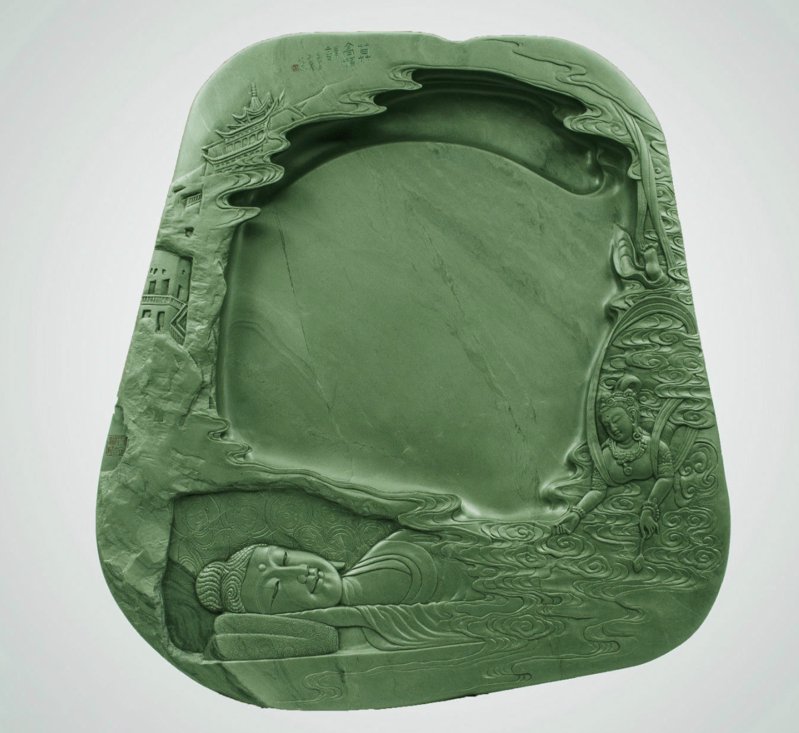
Duan inkstones are said to have been collected from Duanxi in all dynasties. By the time of Lord Li of the Southern Tang Dynasty, Duanxi inkstones had been exhausted, so the next best inkstone was used as a last resort. She inkstone and Duan inkstone are both called together, and Duan inkstone is better than She inkstone because the best Duan inkstone has been immersed in water for many years and is as warm and moist as jade.
Duan inkstone is the top quality inkstone. Duan inkstone was produced in the area of Duanxi River at the western foot of Lanke Mountain in the southeast of Zhaoqing City, Guangdong Province. Zhaoqing was called Duanzhou in ancient times, and the inkstone made of stone here was called "Duan Inkstone". Duan inkstone was discovered during the Wude period of the Tang Dynasty. Duan inkstone is of excellent quality, delicate, tender, moist, and has the characteristics of making ink without hurting the hair and being able to grind the ink when breathing.
The place where end stones are collected is usually three or four miles away from the riverside. It gradually rises and is divided into quarrying places such as Xiayan, Zhongyan, Shangyan, Longyan and Bengkeng. The Xiayan cave is at the bottom of the mountain and is flooded all year round. The stone is precious and moist, so the quality of the lower rock is the best. However, it is not easy to mine the lower rock submerged in water. It can only be entered every autumn and winter when the river water drops. There is no outlet for the pond water, so manpower is required to drain the pond water before entering to collect stones. Therefore, the collection of end stones can only be done during the dry season of autumn and winter, when the quarrying time is short and the conditions are difficult. If you wait until the water rises the next spring, you will have to start all over again.
The mining of Duan Stone is very arduous, so ancient inkstones are really hard to come by. Su Dongpo, a writer and calligrapher in the Song Dynasty, said in "Duanxi Inscription": "Thousands of big silkworms are pulled, and hundreds of people carry heavy weights; they are lowered under the bonfire to bring out the treasures." It can be seen that the quarrying process is very arduous. In "The Song of Yangsheng Duanzhou Blue and White Purple Stone Inkstone", Li He, a poet of the Tang Dynasty, used "Duanzhou stoneworkers are as skillful as gods, sharpening their swords and cutting purple clouds in the sky" to praise the preciousness of Duanshi and the superb quarrying of Duanzhou stoneworks. skill.
Duan Inkstone also has another characteristic, which is that it has "eyes". For example: "parrot eyes", "brother's eyes", etc. It is said that if the stone is young, the eyes will be more, and if the stone is old, the eyes will be few. There are also eyes to determine the quality. The highest quality is live eyes, followed by tearful eyes, dead eyes, etc. . In fact, the so-called "eyes" are the stone patterns on the inkstone.
The color of the end stone is also considered to be related to the quality, and there are purple, green, white and other colors, with white being the best and purple being the worst.
The advantages of Duan inkstone are: firstly, it can release ink, secondly, it can emit ink, and thirdly, it does not damage the inkstone.
She inkstone, as famous as Duan inkstone, was named after it was produced in ancient Shezhou (now Wuyuan County, Anhui Province). She Yan became famous all over the world because of Lord Li, and his reputation was even greater than that of Duan Yan. The official mining of She inkstone did not begin until the Southern Tang Dynasty. Its location was also immersed in water, so its texture was moist.
She inkstones have "patterns", which are like the eyes of the inkstone. The so-called ribbed inkstones have stone patterns like Luogu gourds. The patterns are divided into thick and thin, and the fine lines are the genius of inkstones, and the thick and thick ribs are also top-grade, both of which are comparable to Duanxi Xiayan. The Meizi inkstone, on the other hand, has stone patterns that look like people, and is named after the thrush, which is no different from the ribbed inkstone. The characteristics of She Inkstone are the same as those of Duan Inkstone. The difference is that "She Inkstone" focuses on making ink and writing big characters, while "Duan Inkstone" focuses on finely moistening and stopping water and writing small characters.
Chengni inkstone is a kind of non-stone inkstone material of ceramic inkstone. The production method is as follows: use filtered fine mud as the material, mix it with yellow pill dough and knead it vigorously, then put it into a mold to shape it, carve it with a bamboo knife, wait for it to dry and put it into the kiln for firing, and finally wrap it with black wax and bake it. The production of Chengni inkstones began in the Jin and Tang Dynasties and flourished in the Song Dynasty. Its characteristics are hard and wear-resistant, easy to produce ink, and does not consume ink, which is comparable to stone inkstones. The colors of Chengni inkstone are mainly eel yellow, crab shell green and rose purple. In the Tang Dynasty, Guozhou (now south of Lingbao County, Henan Province) has become a famous producing area for making pure mud inkstones. In modern times, the producing areas of pure mud inkstones include Luoyang in Henan, Julu in Hebei, Qingzhou in Shandong, Jiangxian in Shanxi, Ezhou in Hubei, Tongzhou, Sichuan and Baoshan, Jiangsu.
How to choose a good inkstone? Mainly made of stone, there are many inkstone materials. Inkstones can be made from copper, jade, brick, tile, pottery, and stone. Among them, jade inkstone is the top grade.
Inkstone is the most expensive and moist, and Duan and She are famous for it. If it is not moist, the water in the ink will be easily absorbed, resulting in too high concentration and difficulty in writing. Duan and She stones have been immersed in the stream for many years, so they are moist and shiny. Whether they are moist or not can be distinguished by sight. ——Moisturizing and shiny.
Secondly, the inkstone with a fine texture is preferred. If the inkstone has a fine texture, the surface will be smooth, easy to grind ink, and the ground ink will be even and fine. This kind of inkstone not only emits ink, but also does not damage the pen, end, and edge. All kinds of inkstones are top grade in inkstones. If the surface is uneven and the inkstone makes a sound, the ink will be rough and uneven, and the pen edge will be damaged. This can be seen through sight, touch, and observation, and is not difficult to understand.
When choosing an inkstone, if the inkstone is relatively hard and the sound of the inkstone is high, then the quality is poor, while the one with low sound and rhyme is better.
A good inkstone also needs to be moistened. It needs to be replaced with fresh water every day to maintain it. The inkstone pool should not be short of water, that is, to maintain the inkstone. Be sure to change the water before writing. Don't be too lazy to grind the ink directly with an inkstone. Do not use tea or sugar water to grind the ink. Mixing these things with the ink will greatly reduce the color of the ink and prevent the ink from being produced. Hot water will damage the ink, so remember to avoid it.
After using the inkstone, the remaining ink must be washed away and cannot be allowed to condense on the inkstone. Otherwise, the remaining ink will dry out and form slag blocks, which will hinder grinding, damage the pen surface, and damage the inkstone surface. If it is mixed with new ink, there will be no benefit in placing ink or making ink.

